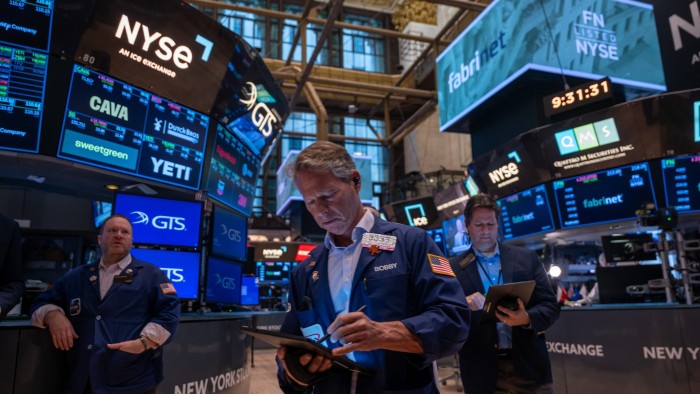The livid rally in US belongings sparked by the tariff détente between Washington and Beijing has caught massive buyers off guard, colliding with widespread bets towards the greenback and Wall Road shares.
The S&P 500 has rallied 3.3 per cent this week, erasing all of its losses this yr, after the US and China agreed to chop tariffs for at the least 90 days, signalling an finish to the worst of the commerce warfare. The greenback rose too, whereas US authorities bond costs have dropped as merchants exit conventional havens.
The push of cash again into shares has stung massive asset managers and different institutional buyers, who have been cautiously positioned on US belongings on fears of a dramatic financial slowdown and broader worries over US policymaking.
“I believe the market bought caught fairly offside,” stated Robert Tipp, head of world bonds at PGIM Fastened Revenue. “Because the climbdowns and offers began to look extra believable — although there are nonetheless lots of tariffs by fashionable requirements — that has compelled a reassessment and a serious place squaring.”
Broader unfavorable bets, together with these by trend-following hedge funds, could have exacerbated the strikes greater as merchants have been squeezed out of their positions, analysts stated.
A fund supervisor survey from Financial institution of America, which was largely accomplished earlier than the US-China announcement, discovered respondents had their dimmest view of US shares in two years.
The BofA survey respondents additionally had probably the most unfavorable collective view of the greenback since 2006. That was backed up by Commodity Futures Buying and selling Fee knowledge, which confirmed that asset managers final week had the most important bullish bets on the euro since September 2024.
Charlie McElligott, a strategist at Nomura, added, “primarily, each thematic macro commerce of the previous few months goes [the] unsuitable means.”
In an indication of the dramatic shifts in sentiment, the Nasdaq Composite has surged almost 30 per cent from a low simply weeks in the past, after Trump’s April 2 “liberation day” tariff announcement shook markets.

The CFTC knowledge, which covers the seven-day interval ended Could 6, additionally confirmed that asset managers had their largest ever lengthy place in 10-year Treasury futures, a guess that costs would rise and yields would fall.
The ten-year yield is especially delicate to development expectations, so the commerce urged that buyers have been betting on greater possibilities of a recession later this yr. It has jumped to 4.45 per cent from a closing low in early April of about 4 per cent.
“There are some institutional buyers who had de-risked fairly considerably. And there was a great deal of money on the sidelines,” stated Gargi Chaudhuri, chief funding and portfolio strategist for the Americas at BlackRock.
The dramatic restoration in shares has been accompanied by a fall in market expectations of volatility. The Vix, Wall Road’s “worry gauge”, is again at pre-liberation day ranges. Expectations of swings within the euro-dollar alternate charge have fallen to their lowest since March, in response to an index supplied by derivatives large CME Group.
Deutsche Financial institution knowledge means that retail buyers could have benefited from shopping for the dip, snapping up shares all through most of April whereas skilled buyers held off.
The S&P’s rally over the previous month has been pushed by shopping for throughout common New York money buying and selling hours, when beginner buyers are most energetic, the financial institution stated. In distinction, returns throughout in a single day buying and selling, when institutional buyers proceed to buy inventory futures and derivatives, “have been muted”.
Some asset managers warn that this shift in the direction of commerce optimism has run too far. “We must always bear in mind the coverage chaos injury to client and enterprise confidence earlier than getting too optimistic,” stated Andrew Pease, chief funding strategist at Russell Investments.
Particularly, buyers stated the greenback, which gave up Monday’s positive factors on Tuesday and Wednesday, may weaken because the financial impression of the commerce disruption turns into clear.
“My guess is that it is a momentary reduction for the greenback, and the tariff charges can be excessive sufficient to have a stagflationary impression on the US economic system, stated Athanasios Vamvakidis, head of world G10 FX technique at Financial institution of America. “For the greenback to weaken once more, we’d like the US knowledge to weaken — we consider it is going to.”
Dominic Schnider, head of world FX & commodities at UBS’s wealth administration arm, stated buyers “have but to see how a lot the injury [from the trade war] goes to be”.
















